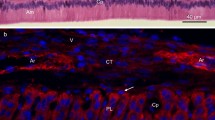Summary
Sections of glutaraldehyde-OsO4-fixed, plastic-embedded rat incisor enamel were left untreated, stained, decalcifed (1% formic acid in 10% sodium citrate), or decalcified-stained. The presence of apatite crystals was monitored with electron diffraction. After brief decalcification and staining, apatite crystals and matrix components were visualized in the same field. The ghost was continuous with crystal fragments, and the coat appeared as a dense line next to crystals and ghosts. Position of ghosts and crystals at the ameloblast-enamel junction (AEJ) of the secretion zone suggested that there may be a lag of no more than 1/5 min between the elaboration of ghost and crystal. A major change in enamel morphology occurs between the AEJ and the deep enamel of the secretion zone. The ghost becomes thinner, the coat more pronounced, and the crystal enlarges. There is only little change from the deep secretion to the maturation zone enamel.
Similar content being viewed by others
References
Bai P, Warshawsky H (1985) Morphological studies of the distribution of enamel matrix proteins using routine electron microscopy and freeze-fracture replicas in the rat incisor. Anat Rec 212:1–16
Bishop MA, Warshawsky H (1982) Electron microscopic studies on the potential loss of crystallites from routinely processed sections of young enamel in the rat incisor. Anat Rec 202:177–186
Bonucci E (1967) Fine structure of early cartilage calcification. J Ultrastruct Res 20:33–50
Bonucci E (1979) Presence of crystal ghosts in bone nodules. Calc Tissue Int 29:181–182
Bonucci E (1984) Crystal-matrix relationships in calcifying organic matrices. INSERM 125:459–472
Decker JD (1973) Fixation effects on the fine structure of enamel crystal-matrix relationships. J Ultrastruct Res 44:58–74
Frank RM, Nalbandian J (1963) Aspects ultrastructureaux du mécanisme de la calcification. Arch Oral Biol [Spec Suppl] pp 95–109
Frazier P (1968) Adult human enamel: an electron microscopic study of crystallite size and morphology. J Ultrastruct Res 22:1–11
Greep RO, Fischer CJ, Morse A (1948) Alkaline phosphatase in odontogenesis and its histochemical demonstration after demineralizaton. J Am Dent Ass 36:427–442
Jessen H (1968) Elliptical tubules as unit structures of forming enamel matrix in the rat. Arch Oral Biol 13:351–352
Kallenbach E (1973) The fine structure of Tomes' process of rat incisor ameloblasts and its relationship to the elaboration of enamel. Tiss Cell 5:501–524
Kallenbach E (1982) Fine structure of extracted rat incisor enamel. J Dent Res 61:1515–1523
Kerebel B, Daculsi G, Kerebel LM (1979) Ultrastructural studies of enamel crystallites. J Dent Res 58(B):844–851
Liem RSB, Jansen HWB (1982) Preparation of partially decalcified sections of human dental enamel for electron microscopy. Caries Res 16:217–226
Nakahara H, Kakei M (1983) The central dark line in developing enamel crystallite: an electron microcopic study. Bull Josai Dent Univ 12:1–7
Nanci T, Bai P, Warshawsky H (1983) The effects of osmium postfixation and uranyl and lead staining on the ultrastructure of young enamel in the rat incisor. Anat Rec 207:1–16
Nylen MU (1979) Matrix-mineral relationships — a morphologists viewpoint. J Dent Res 58(B):922–929
Nylen MU, Eanes ED, Omnell KA (1963) Crystal growth in rat enamel. J Cell Biol 18:109–123
Reith EJ (1960) The ultrastructure of ameloblasts from the growing end of rat incisors. Arch Oral Biol 2:253–262
Risnes S (1979) A method of calculating the speed of movement of ameloblasts during rat incisor amelogenesis. Arch Oral Biol 24:299–306
Ronnholm E (1962) The amelogenesis of human teeth as revealed by electron microscopy.II. The development of the enamel crystallites. J Ultrastruct Res 6:249–303
Scott DB, Nylen MU (1962) Organic-inorganic interrelationships in enamel and dentin — a possible key to the mechanism of caries. Int Dent J 12:417–432
Sundstrom B, Takuma S (1971) A further contribution on the ultrastructure of calcifying cartilage. J Ultrastruct Res 36:419–424
Travis DF, Glimcher MJ (1964) The structure and organization of, and the relationship between, the organic matrix and the inorganic crystals of embryonic bovine enamel. J Cell Biol 23:447–497
Warshawsky H (1968) The fine structure of secretory ameloblasts in rat incisors. Anat Rec 161:211–230
Yanagisawa T, Nylen MU (1980) The relationship between matrix and mineral in rat enamel — an electron microscopic study. J Dent Res 59: (A) 343
Yanagisawa T, Takuma S (1982) Ultrastructural relationships between matrix and crystal in enamel. Jpn J Oral Biol 24:777–787
Author information
Authors and Affiliations
Rights and permissions
About this article
Cite this article
Kallenbach, E. Crystal-associated matrix components in rat incisor enamel. Cell Tissue Res. 246, 455–461 (1986). https://doi.org/10.1007/BF00215908
Accepted:
Issue Date:
DOI: https://doi.org/10.1007/BF00215908




